Learn About The Total Solar Eclipse April 8, 2024
One of nature's most awesome sights will be happening in the Cleveland area and many parts of North America. A time when daylight briefly turns into twilight. 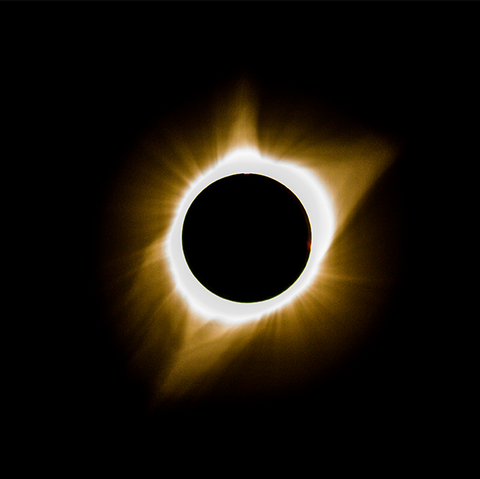
On April 8, 2024, a rare celestial event called a total solar eclipse will occur. The photo shows the totality phase of the Aug. 21, 2017 total solar eclipse as seen from Casper, Wyoming. (From: NASA.gov Credit: Keon Gibson)
You may be wondering why Chagrin Valley Soap, an organic skin care company, is writing about an eclipse. For those of you who follow our blogs, you already know that the founder, Ida (that's me) is a totally passionate science nerd (plus I miss teaching).
Although the last total eclipse in the United States was in 2017, totality was not visible in Ohio. The last total solar eclipse visible in Cleveland was on June 16, 1806 about a decade after Moses Cleaveland founded the city (yes, his name is spelled with an "a"). Cleveland will not be in the path of totality again until the year 2444.
So for me and Cleveland, this is a once-in-a-lifetime event and I am super excited.
What Is A Solar Eclipse?
A solar eclipse occurs when our Moon passes between the Sun and Earth, casting the Moon's shadow on Earth.
Two things need to happen at once for you to see a total solar eclipse
- the Sun, Moon, and Earth need to be in a straight line, with the Moon between the Sun and Earth
- you need to be standing in the correct spot on Earth
As you will see throughout this blog's many many pictures, I am a visual learner. So I thought I would start out with this great little 5 minute video from National Geographic.
What Is The Difference Between a Total Eclipse and a Partial Eclipse?
A solar eclipse occurs when our Moon passes between the Sun and Earth, completely or partially blocking our view of the Sun and casting a shadow on Earth. But not all solar eclipses are the same.
The Sun is so large that during a solar eclipse the Moon casts two shadows on Earth. The first shadow is called the umbra. This shadow gets smaller and smaller as it reaches Earth. In the picture below (which is not to scale) it is the dark blackish center of the Moon’s shadow. People standing in the umbra will see a Total Solar Eclipse. During the few minutes of 100% totality, stars and planets will emerge and you can see the bright outer atmosphere of the Sun called the corona.
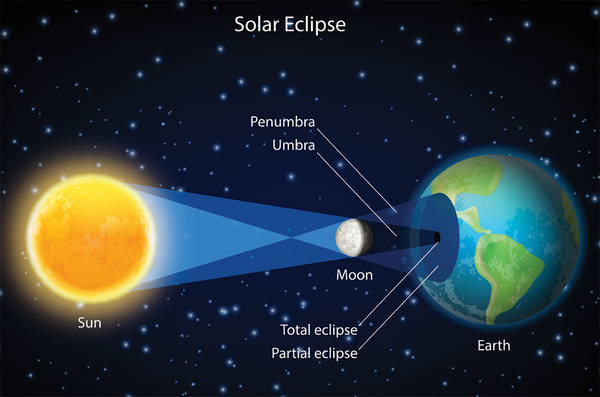
The second shadow is called the penumbra. Notice that the penumbra gets larger as it reaches Earth. People standing in the penumbra will see a partial eclipse. In the picture it is the dark blue cone of the Moon’s shadow. The area experiencing a partial eclipse is much wider than that of the total eclipse.
If you look at the partial with your eclipse glasses or allow the Sun to shine through a pinhole projector aimed at a piece of paper or the ground, a partial solar eclipse will look as if a bite has been taken out of our Sun. It is important to wear eclipse glasses when viewing any partial solar eclipse. Staring directly at the Sun can cause eye injury (more about that later).
If you are outside on a sunny day during a partial solar eclipse and have not been told it was happening, the sky may become a bit darker as if it were cloudy, but there would be no clouds. So why are we seeing bright daylight when the Sun is partially eclipsed by the Moon?
Think about how much light there is at night during a full moon. Well, the Sun is about 400,000 times brighter than a full moon. So basically it would take the light of 400,000 full moons to equal the brightness of the Sun. Even if the Sun is 90% covered, the rays of the Sun are so bright that even 10% is a lot of light. Since our eyes are very sensitive to light, even a small amount of sunlight will still appear very bright. Also, our atmosphere scatters and refracts (bends) the sunlight adding to the brightness.
When experiencing a total solar eclipse the sky will still appear pretty bright until the last few seconds before totality when the light does get noticeably darker and then fades when totality occurs.
By the way, a solar eclipse can only occur during the day, if you have seen an eclipse at night then you have seen a lunar eclipse.
How Can Our Small Moon Cover Our Large Sun?
Of course, our Sun and Moon are not really the same size. The Sun is 400 times the diameter of the moon, but it is also 400 times farther away from us. This relationship between size and distance makes the Sun and the Moon appear similar in size in the sky. Our Earth is the only planet in our solar system with a moon the proper size and distance to cause a solar eclipse.
By the way the Sun and Moon are not always the same size as seen from Earth. The Moon’s orbit is not a perfect circle, it has an elliptical (oval) shape. So its distance from Earth varies slightly over the course of a single month. During the April 2024 eclipse, our Moon will be at a point in its orbit that’s comparatively near to Earth. That will make the Moon appear especially large and also make the period of totality a few minutes longer.
The Moon revolves around the Earth once every month (about every 28 days). For some days of every month the Moon is in a farther part of its orbit from Earth and some days it is closer. A total solar eclipse is only possible when the Moon is closer to Earth than average.
When the Moon is farther away in its orbit, its apparent size is smaller than the Sun’s, so it does not completely block the Sun’s bright disk. If an eclipse happens during this time, the outer part of the Sun’s surface, a ring of fire, will appear around the Moon. This is called an annular eclipse. Although it is still quite beautiful to witness, the sky does not darken and you can never look at this eclipse without special glasses.
Will You Be Able To See The Total Eclipse Where You Live?
As the Moon blocks the Sun’s rays during a total eclipse, it casts its umbral shadow on part of the Earth which creates a trail as Earth rotates. This trail is called the path of totality.
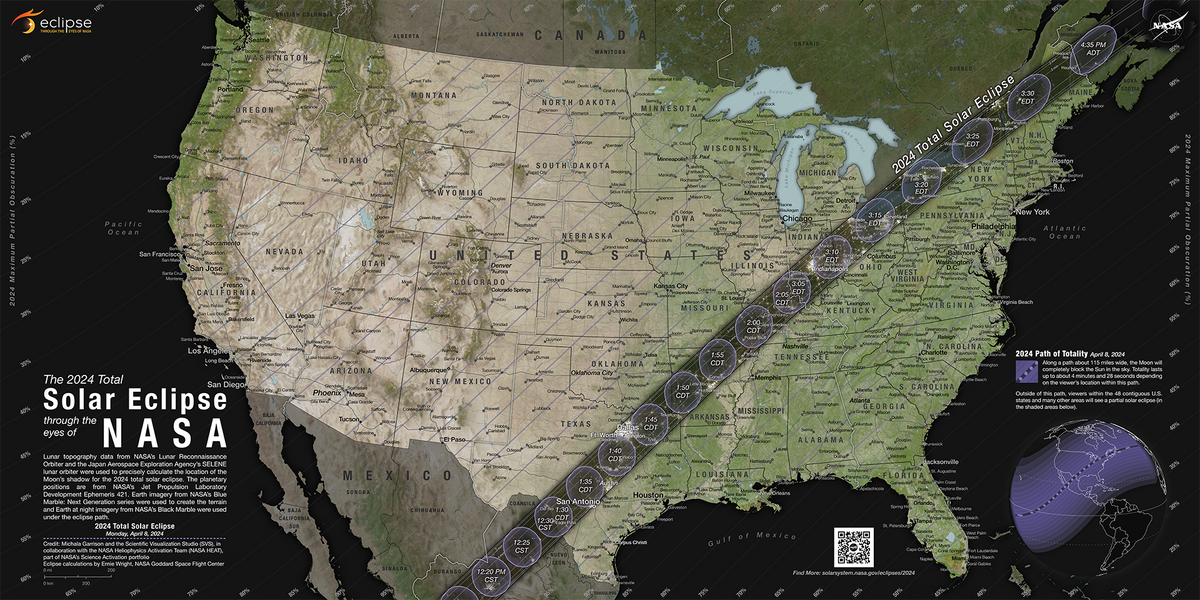
The map from NASA's website illustrates the path of the Moon’s shadow across the U.S. during the 2024 total solar eclipse.
If you want to experience almost total darkness during an eclipse, you have to be in the path of totality. In that path, the Moon completely blocks the Sun’s light for a few minutes. It gets so dark that it looks like night time during a full moon.
What time is the 2024 eclipse? The time the eclipse occurs at any place varies across the Northern Hemisphere. We also have to take into account the change in time zones. Check your city on the internet for the exact times in your area.
Weather permitting, the first location in continental North America that will experience totality is the Pacific coast of Mexico at around 11:07 a.m. PDT (Pacific Daylight Time). The eclipse will exit continental North America on the Atlantic coast of Newfoundland, Canada, at 5:16 p.m. NDT (Newfoundland Daylight Time).
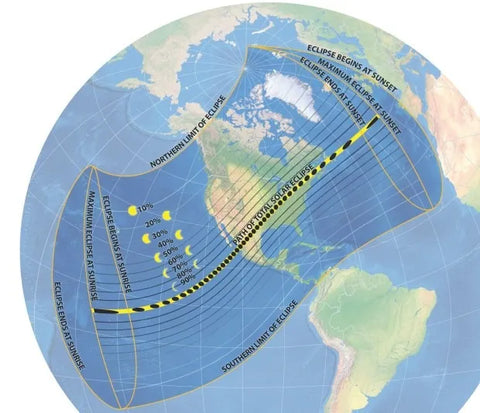
For the Cleveland, Ohio area, the partial eclipse begins at 1:59 EDT as our Moon begins its journey across our Sun. You can watch its journey using eclipse glasses.
The point at which the Sun is completely covered by our Moon, the total eclipse or totality, begins at 3:13 pm. It will plunge the Cleveland area into the darkness of twilight for just under 4 minutes. The Sun totally returns at 4:29 pm.
The map of the globe shows the extent of the Moon’s outer shadow (penumbra) where a partial eclipse is seen and the inner shadow (umbra) where totality is seen. The little black ovals depict the Moon’s shadow at five-minute intervals. (Picture from: Astonomy.com Michael Zeiler)
NASA has a really cool video that shows how the path of totality as well as the penumbral shadow as it scoots across the Northern Hemisphere.
Why Don't We See A Solar Eclipse Every Month?
A solar eclipse happens when a "new moon" moves between the Earth and the Sun blocking some or all of the Sun's rays.
As you can see in the diagram taken from Space.com, a "New Moon" occurs once a month when the Moon is between the Earth and the Sun. We don't see the new moon phase from Earth because the part of the Moon illuminated by the Sun faces the Sun and non-illuminated part of the Moon faces the Earth.
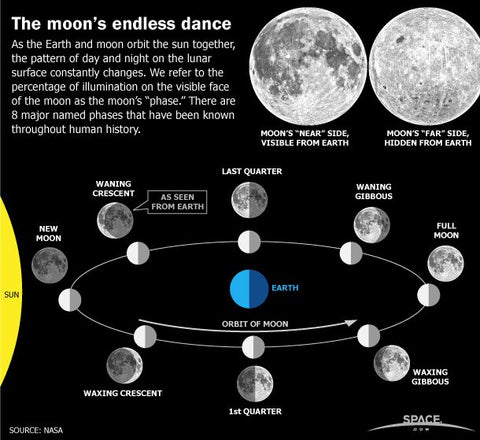
But wait, if a New Moon occurs once every month and our Moon passes between the Earth and the Sun every month, why is there no eclipse every month?
Most of the time, the Moon’s shadow misses our planet because the Moon’s orbit is not completely lined up with the Earth's orbit around the Sun. The orbit of our Moon is tilted by about five degrees, which means that when the Moon moves between Earth and the Sun, the three bodies are out of alignment.
As a result, our Moon does not block the Sun's rays going to the Earth, and the shadow of the Moon is either too high above Earth or too low and lands in space instead of on Earth’s surface. This is a typical new moon phase.
When all the orbits line up we get an eclipse. A total solar eclipse occurs somewhere on Earth about every 18 months. However it only recurs at any given location every 360–410 years on average.
One thing to note is that since the Moon is in its New Moon phase and only the non-illuminated part of the Moon faces the Earth, you will not be able to see the Moon while it moves across the sky as you are awaiting the solar eclipse to begin.
What Can You See During a Total Solar Eclipse?
First of all you need clear skies to have the best total eclipse experience. However, the unusual and eerie daytime darkness associated with a total eclipse is still noticeable even with cloud cover. Also, in order to see all stages of a total solar eclipse, you must view it from somewhere along the path of totality.
Safety Note: You must not remove your eclipse glasses until the Moon has completely covered the Sun, the portion of the eclipse known as “totality.” (see Safety below)
There are five stages in a total solar eclipse.
FIRST CONTACT
A total eclipse begins with first contact as the partial eclipse begins. As the Moon begins to travel across the face of the Sun, the Sun appears to have a crescent shape which looks like a "bite" has been taken out of the Sun. Remember before first contact you will not be able to see the "new moon" in the sky since the illuminated side is facing the Sun, not the Earth.
During first contact, and for the next 80 minutes or so, the sunlight levels appear normal but the skies will slowly begin to darken (like a cloudy day) as the Moon starts to make its way across the surface of the Sun.
Fun Fact: As you look into the sky during an eclipse, the Moon actually approaches the Sun from the right (the west) as seen from the Northern Hemisphere. This may seem odd.
Since our Earth rotates on its axis from west to east, all objects in our sky appear to move from east to west including the Moon. However, since our Moon orbits our planet in the same direction as the Earth rotates, the Moon actually moves from west to east through our sky. The movement is so slow that we never notice it except during a total solar eclipse when we can see the Moon’s true motion as it crosses the Sun’s face from west to east.

Photo from The American Astronomical Society
SECOND CONTACT
The next phase, called second contact, happens a few minutes before totality. You may notice changes in wildlife around you and birds may stop singing as the skies darken.
A few seconds before totality, you might see brilliant points of light at the edge of the Moon’s shadow called Bailey’s Beads. These bright specks are caused by the last rays of the Sun shining through mountains and between the valleys on the edge of the Moon. Baily’s Beads are beautiful but may not last long enough to be noticeable.
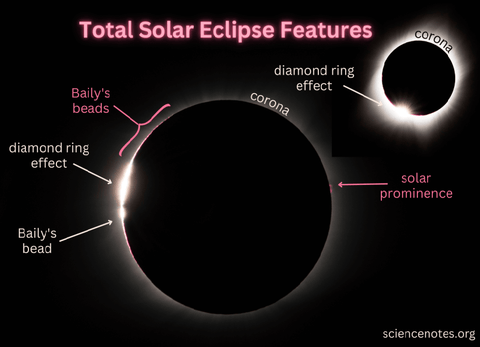
Baily’s Beads will begin to disappear one by one until one solitary point of light remains along the edge of the Moon’s shadow. This shiny area of light is known as the Diamond Ring effect since the bright spot resembles a giant diamond ring which is formed by the rest of the Sun’s atmosphere. (Picture from ScienceNotes.org)
Totality is almost here – but keep those eclipse glasses on!
TOTALITY
Once the diamond ring disappears and there is no longer any direct sunlight, you may remove your eclipse glasses and look at the total eclipse safely with the naked eye.
Totality takes place when our Moon covers the entire surface of our Sun. At this point in time, only the Sun’s corona is visible. The skies darken even further, but not as dark as a typical night. You may also notice a distinct drop in temperature because solar radiation in the umbra is reduced.
Animal Behavior: You will probably notice that crickets may begin chirping, birds may stop singing, and bees want to return to their hives. You may see nocturnal animals like raccoons, come out to play and even domestic animals like cows and horses will not be quite sure what to do.
During totality you may be able to see the chromosphere, a region of the solar atmosphere, that appears as the thin pink circle around the Moon as well as the corona which is the outer solar atmosphere that appears as streams of white light.
During this 2024 eclipse, totality will last about 3 to 4 minutes depending on your location in the path of totality. Take a few moments to observe the sky.
Depending on the light pollution in your area you may be able to see some constellations. Two planets will also be quite visible. Bright and brilliant Venus will appear 15 degrees to the lower right of the Sun. Jupiter will also be visible about 30 degrees to the upper left of the Sun. Just for reference your fist held at arm's length measures roughly 10 degrees on the sky's dome. Your pinky at arm's length measures 1 degree.
THIRD CONTACT
Make sure your eclipse glasses are back on before the first flash of sunlight appears around the edges of the Moon.
Third contact is the fourth stage at which time the Moon starts moving away.
What you will see is basically the same as second and first contact but in reverse. You will begin to notice brightening on the opposite side of the Moon, the Diamond ring may be observed again and Baily’s beads reappear.
Once again and we are back to the partial eclipse stage. The skies start to lighten and wildlife begins to be more active as we watch the thin crescent of the Sun gradually become larger and larger as the Moon moves away.
FOURTH CONTACT
The last shadow on the Sun disappears. At this point the partial eclipse ends as the Moon completely leaves the face of the Sun, and the full disc is visible.
Eclipse Safety, Safety, Safety
The first rule for observing a solar eclipse, or for looking directly at the Sun at any other time, is safety first.
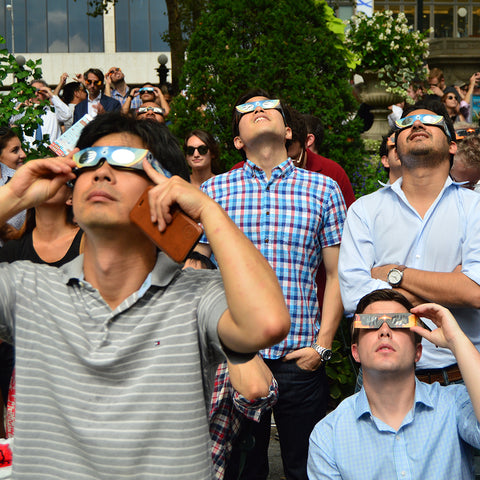
Except during the brief totality phase of a solar eclipse, when the Moon completely blocks the Sun’s bright face, it is not safe to look directly at the Sun without specialized eye protection for solar viewing.
Looking directly at the Sun through anything that is not specially made to deal with all the bright visible light and invisible radiation can lead to serious eye injury and possibly even blindness.
You can view the eclipse directly without proper eye protection only when the Moon completely obscures the Sun’s bright face during the very brief period known as totality. You will know it is safe when you can no longer see any part of the Sun through eclipse glasses or a solar viewer.
But as soon as you see even a little bit of the bright Sun reappear, immediately put on your eclipse glasses to watch the partial eclipse as our Moon moves away from the Sun. The Sun’s surface is so bright that if you stare at any portion of it, no matter how small, it produces enough light to damage the retinal cells in your eyes and it only takes a few seconds for this to happen. Never assume that you can look away quickly enough to avoid eye damage because every person is different in terms of their retinal sensitivity, and you do not want to risk being the one who damages their eyes just to try to look at the Sun.
Eclipse glasses are NOT regular sunglasses. No matter how dark they are, sunglasses are not safe for viewing the Sun. It is also not safe to view an eclipse through a camera lens, binoculars, or a telescope without a special-purpose solar filter.
Eclipse glasses or viewers reduce sunlight to safe levels so that you do not injure your eyes. The glasses should include a notice that states that they meet the requirements of the ISO 12312-2 international standard. But, be careful because counterfeit glasses exist. This means that just seeing the ISO logo or a label claiming ISO 12312-2 compliance is not always good enough. Companies that claim their glasses to be "NASA approved" are not being honest. NASA does not and never will approve and brand of eclipse glasses, and they are very clear on this.
You need to know that the glasses come from a reliable source. I purchased ours from The Cleveland Natural History Museum for $3.00.
Try on the glasses indoors first. Nothing should be visible through the lenses, and even the brightest lights should only appear very faintly, barely there.
Be sure to inspect your eclipse glasses before use and if they are torn, scratched, or damaged in any way discard them. It is not worth the eye injury. Always supervise children using solar viewers.
You can also use an indirect viewing method, such as a pinhole projector which projects an image of the Sun onto a nearby surface and does not involve looking directly at the Sun at all.
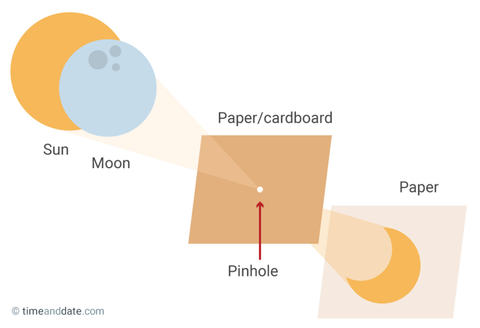
To make a simple pinhole projector take a sheet of paper or an index card and make a tiny hole in the middle using a large pin or thumbtack. The goal is to make a small, smooth, round hole.
Now with the Sun at your back, let the Sun’s light shine through the hole and onto a piece of paper which will act as your screen. You will see an inverted image of the crescent Sun projected onto the paper screen. To make the image on your screen larger hold the paper screen further away from the paper with the pinhole. (From: timeanddate.com)
For extra fun, try poking multiple holes in the pinhole projector. Each hole will become its own projection of the Sun, making for some neat effects. Try using items around your house as a pinhole projector. Any item that has small holes such as a colander or slotted spoon will work.
PLEASE NOTE that pinhole projection does NOT mean looking at the Sun through a pinhole!
If you are around trees with little holes in their leaves or small spaces between the leaves, look at the shadows of leaves on the ground or nearby walls. During a partial solar eclipse, the tiny holes or spaces act as pinhole projectors, dotting the ground with amazing images of the changing crescent Sun.
Fun Facts
- Totality causes the darkness of a deep twilight.
- During the totality phase the Sun’s corona is about as bright as a full moon.
- Although a total solar eclipse occurs somewhere on Earth about every 18 months, you will only see a total eclipse about every 300 to 400 years from the same location on Earth.
- After this April’s spectacular show, the next total solar eclipse to cross the contiguous U.S. will not occur until 2044. During that eclipse, the path of totality will cover only parts of Montana, South Dakota and North Dakota.
- The shadow of the Moon will travel at more than 1,500 miles per hour as it crosses Earth during this April’s total solar eclipse.
- The Moon is moving away from Earth a tiny bit each year. At the current rate, the Moon will appear too small to cause a total solar eclipse in 600 million years.
A total solar eclipse provides a great opportunity for scientists to study the Sun's corona, the outermost part of the Sun's atmosphere. On a typical day, the corona is usually hidden by the bright light from the surface of the Sun, called the photosphere. But during a total solar eclipse, the photosphere is completely blocked by the Moon, leaving the corona and the thin lower atmosphere (chromosphere) visible. Studying these regions of the Sun’s atmosphere can help scientists learn more about solar radiation, solar wind, and the other ways in which the Sun affects space weather and our Earth.
During a total eclipse the corona is able to shine out around our Moon in a spectacular display. Let us all pray for some great viewing weather!
One Last Thought To Share
For the total solar eclipse on April 8, 2024, it is estimated that over 31 million people live in the path of totality and millions more will travel to see totality as it unfolds. We will all stop what we are doing and look up into the sky to experience something we will remember forever.
The science of space is super exciting. There are so many interesting things to learn about our relationship to everything out there in space. Take some time to enjoy the journey of learning.
As you sit in your chair reading this blog the Earth is rotating on its axis at an average speed of about 1,000 miles per hour (1,600 km per hour).
At the same time the Earth is revolving around the Sun at a rate of about 67,000 miles per hour (107,000 km/hr).
Perhaps that why I have so much trouble sitting still ;-)
After The Eclipse--My Thoughts
It is now the evening of April 8th and I can’t stop thinking about the eclipse. For so many weeks I have been reading everything I could, I wrote this blog, and I thought I would know what to expect. But as I sat outside watching with goose bumps, I must admit I was not emotionally prepared for what I experienced.
It was one of the most incredible experiences in my life. I absolutely understand why people travel long distances to see a total solar eclipse.
I watched the entire event from start to finish, but the magic really began around ten minutes before totality when the sun was still partially blocked but almost gone. As the skies grew darker the sounds of daytime became quite, the crickets began singing and there was significant change in temperature--it was quite eerie and awesome at the same time. An American Bald Eagle, flying around our valley, seemed confused (although that could be my imagination).
 As soon as I took off my eclipse glasses I was immediately filled with wonder. The feelings are difficult to express with words. It was surreal and exciting. We were very lucky in the Cleveland area because we had almost 4 minutes to take in the spectacular sight of totality.
As soon as I took off my eclipse glasses I was immediately filled with wonder. The feelings are difficult to express with words. It was surreal and exciting. We were very lucky in the Cleveland area because we had almost 4 minutes to take in the spectacular sight of totality.
I never saw the Bailey's Beads, but I did see the Diamond Ring as the Moon began to move away from the Sun. I saw Jupiter, Venus and something I was not expecting, a easily visible red dot at the bottom of the eclipsed Sun.
According to Sciotopost.com, the red dot was a solar prominence. "Prominences which are occurrences of hot gas or plasma trapped in magnetic field loops extending from the sun’s surface." Although they are not an uncommon site during a total eclipse, "a prominence large enough to be seen with the naked eye during an eclipse is considered a remarkable event."
Our Sun and Moon are two celestial bodies that we seldom think about on a daily basis. But today they came together to create a spectacular sight that reinforced my belief in science and wonder and made me realize that we are just one small part of an incredible universe.
I would love for people share their feelings and thoughts.


